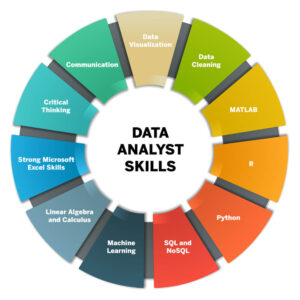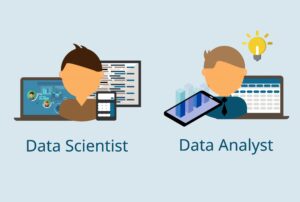Data analytics involves collecting, organizing, analyzing, and interpreting large sets of data to extract valuable insights and make informed decisions. It plays a crucial role in driving business strategies, optimizing processes, and enhancing overall performance.
What does a data analyst do? An overview
Data analysts are responsible for examining data, identifying trends, patterns, and correlations, and presenting findings to support data-driven decision-making. Their key responsibilities include:
-
-
- Collecting and cleaning data from various sources
- Analyzing data using statistical methods and data visualization tools
- Interpreting data to uncover insights and trends
- Developing reports, dashboards, and presentations to communicate findings
- Collaborating with stakeholders to understand business needs and provide actionable recommendations
-
What does a data analyst do? Day-to-day tasks & responsibilities
-
-
- Gathers and cleans data to ensure accuracy and reliability
- Applies statistical techniques and data modeling to analyze complex datasets
- Creates data visualizations, such as charts and graphs, to present insights
- Generates reports and presentations to communicate findings to stakeholders
- Collaborates with teams to develop data-driven strategies and solutions
- Maintains data integrity, security, and compliance with regulatory standards
-
How much do data analysts earn?
Data analyst salaries vary based on experience, industry, and location:
-
-
- Entry-level: $56,234
- Mid-level: $68,934
- Senior: $87,542
- Lead: $102,876
- Manager: $118,342
- Director: $145,120
-
What skills do you need to be a data analyst?
-
-
- Data analytics tools and programming languages (e.g., Python, R, SQL)
- Statistical analysis and data modeling techniques
- Data visualization and reporting tools (e.g., Tableau, Power BI)
- Critical thinking and problem-solving
- Effective communication and storytelling
-
How to become a data analyst
-
-
- Gain proficiency in data analytics tools and programming languages through self-study or formal education.
- Develop analytical skills by working on data projects, participating in data competitions, or internships.
- Obtain certifications in data analytics (e.g., Microsoft Certified: Data Analyst Associate, Google Data Analytics Professional Certificate).
- Build a strong portfolio showcasing your data analysis projects, methodologies, and results.
- Network with data professionals, attend data-related events, and join online communities to stay updated with industry trends and best practices.
-
Advantages and Challenges of Being a Data Analyst
Being a data analyst offers several advantages:
-
-
- High Demand: Data analysts are in high demand across industries due to the growing importance of data-driven decision-making.
- Career Growth: Data analysts can progress to senior roles such as data scientist, data engineer, or analytics manager with experience and additional skills.
- Continuous Learning: Data analysts continuously learn and adapt to new technologies, tools, and techniques in the rapidly evolving field of data analytics.
- Impactful Insights: Data analysts play a crucial role in providing actionable insights and recommendations that drive business strategies and decisions.
-
However, there are challenges to consider:
-
-
- Data Quality: Ensuring data accuracy, completeness, and reliability can be challenging, requiring thorough data cleaning and validation processes.
- Complexity: Analyzing large and complex datasets may require advanced statistical techniques, data modeling, and domain knowledge.
- Data Privacy and Security: Data analysts must adhere to data privacy regulations and security measures to protect sensitive information and maintain data integrity.
- Communication: Effectively communicating technical findings and insights to non-technical stakeholders can be challenging and requires clear, concise, and compelling storytelling skills.
-
Future Trends in Data Analytics
Data analytics is evolving with emerging trends:
-
-
- Advanced Analytics: Leveraging advanced analytics techniques such as machine learning, artificial intelligence, and predictive modeling to gain deeper insights and drive predictive analytics.
- Big Data Management: Managing and analyzing large volumes of structured and unstructured data using big data technologies and platforms (e.g., Hadoop, Spark, NoSQL databases).
- Cloud-Based Analytics: Adopting cloud-based analytics solutions for scalable data storage, processing, and analytics capabilities.
- Ethical Data Use: Integrating ethical considerations, responsible data practices, and data governance frameworks to ensure ethical data use and mitigate risks.
- Automated Insights: Implementing automated analytics solutions and natural language processing (NLP) for automated insights generation and reporting.
-
Conclusion
Data analytics is a dynamic and impactful career path that requires a combination of technical expertise, analytical skills, and effective communication. By gaining proficiency in data analytics tools, developing analytical skills, obtaining certifications, building a strong portfolio, and staying updated with industry trends, aspiring data analysts can excel in harnessing the power of data to drive business success.
What You Should Do Now
-
-
- Become a Qualified Data analyst in 1-63 months—backed by the FandF Consultancy Job assistance guarantee.
- This month, we’re offering Early Registration Scholarships—worth up to 20% off our career-change programs—to the first 80 people who apply 🚀 Book your application call today!
-




